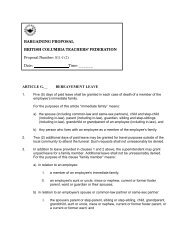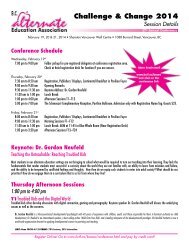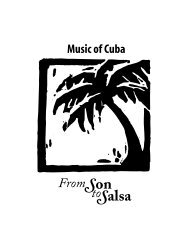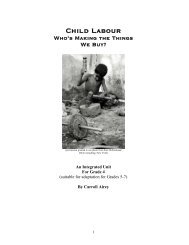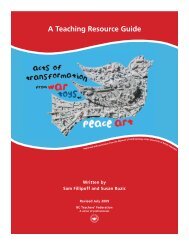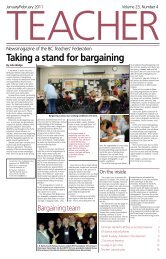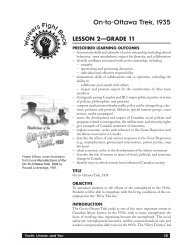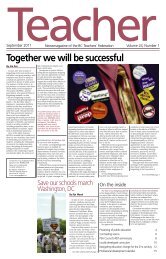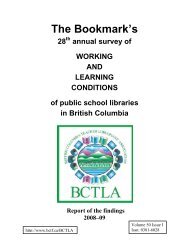“That's so gay” is so yesterday
“That's so gay” is so yesterday
“That's so gay” is so yesterday
Create successful ePaper yourself
Turn your PDF publications into a flip-book with our unique Google optimized e-Paper software.
“ That’s<br />
<strong>so</strong> <strong>gay”</strong><br />
Please PosT in hallways and Classrooms<br />
<strong>is</strong> <strong>so</strong> <strong>yesterday</strong><br />
Be a change maker... Challenge<br />
homophobia!<br />
BC Teachers’ Federation • Professional and Social Issues • 604-871-1842 • See re<strong>so</strong>urces on reverse<br />
Source image: Design Pics Inc.
elementary Teaching strategies:<br />
responding to “That’s <strong>so</strong> gay!”<br />
Acknowledge the initial d<strong>is</strong>comfort that <strong>so</strong>me students may have in d<strong>is</strong>cussing th<strong>is</strong> topic. Tell them it <strong>is</strong><br />
natural to initially feel th<strong>is</strong> way, because it <strong>is</strong> not <strong>so</strong>mething we normally d<strong>is</strong>cuss at school, but we need to<br />
in order to keep everyone safe. Then move dec<strong>is</strong>ively forward with one of the following strategies.<br />
SHORT-TERM INTERvENTIONS<br />
1. Ask, How would you feel if part of your identity was inserted instead of gay? e.g., That’s <strong>so</strong> Punjabi,<br />
Catholic, Korean, etc., and it was used repetitively with the same tone of voice.<br />
2. Ask, What does that mean? or say, That’s <strong>so</strong> what? to create a conversation around the negative use<br />
of the word gay. Typical student response, It’s stupid/weird, etc. Teacher response, That’s the same as<br />
saying gay people are stupid/weird. Is that a helpful or hurtful comment to make?<br />
3. Ask, How can a book/idea/<strong>so</strong>ng have a sexual orientation? if they are referring to an inanimate object<br />
when using th<strong>is</strong> slur. Use humour in appropriate ways to relieve tension with students, but still make<br />
your point that the comment <strong>is</strong> unacceptable.<br />
4. Teach students that “<strong>gay”</strong> <strong>is</strong> a good word when it <strong>is</strong> used to describe a per<strong>so</strong>n or family they care<br />
about.<br />
5. Say, You might be surpr<strong>is</strong>ed to know that what you just said could be offensive to others. Tell students<br />
that many people have LGBTQ family and friends. They would be offended. Al<strong>so</strong> LGBTQ people<br />
themselves may hear that comment and think less of you if you made that comment.<br />
6. Say, Th<strong>is</strong> <strong>is</strong> a homophobia-free zone. That means we can’t make comments that would be hurtful to<br />
gay or lesbian people or their families.<br />
7. Show the NFB video, Sticks and Stones, about homophobic name calling in school. To borrow from<br />
the BCTF Information Services Department, e-mail video@bctf.ca, or call Lesley Harrington at<br />
604-871-2241.<br />
8. Order classroom posters on th<strong>is</strong> topic from the BCTF. Call 604-871-1801. Post them throughout your<br />
school.<br />
9. Debunk negative myths about LGBTQ people. Say, Gay <strong>is</strong> OK. Teachers should be explicit and<br />
ask students what the words gay and lesbian mean (when two women or two men love each other<br />
romantically, etc.) <strong>so</strong> that the connection <strong>is</strong> clear for students.<br />
10. Make links between homophobic slurs and other forms of d<strong>is</strong>crimination. Help your students to<br />
understand analogies between rac<strong>is</strong>m, sex<strong>is</strong>m, able<strong>is</strong>m, ethnocentr<strong>is</strong>m, etc.<br />
LONG-TERM INTERvENTIONS<br />
Log onto the Pride Education Network’s website at www.pridenet.ca to find les<strong>so</strong>n plans and re<strong>so</strong>urces<br />
on how to teach about the harmful effects of all forms of name calling, including anti-LGBTQ ones. Order<br />
the Dealing with Name Calling handbook from the Pride Education Network to teach a series of les<strong>so</strong>ns<br />
on how students can respond to name calling in assertive ways to keep themselves safe.<br />
Read picture books to students which deal with <strong>is</strong>sues of homophobia, sex<strong>is</strong>m, rac<strong>is</strong>m, etc. and have<br />
students identify the common hurts between these forms of oppression. For older students, do a novel<br />
study on a book where homophobia <strong>is</strong> one of the central challenges faced by the protagon<strong>is</strong>t.<br />
Have students write paragraphs about homophobia, including what it looks and <strong>so</strong>unds like, as well as<br />
how they can protect themselves from incidences of it. Make sure to teach them about the importance of<br />
not being a bystander within these situations.<br />
For secondary students—<br />
strategies to challenge “That’s <strong>so</strong> gay!”<br />
Les<strong>so</strong>n plans are on the PEN website. See the Re<strong>so</strong>urces link at www.pridenet.ca.<br />
The BCTF al<strong>so</strong> has many les<strong>so</strong>n plans at www.bctf.ca/SocialJustice.aspx?id=21521&libID=21511.<br />
SHORT-TERM ACTIONS<br />
Interrupt the conversation and state that<br />
th<strong>is</strong> comment <strong>is</strong> homophobic. Like rac<strong>is</strong>t<br />
and sex<strong>is</strong>t comments, homophobic ones<br />
will not be tolerated in your class<br />
or school.<br />
If the comment was witnessed by the<br />
class, you can address the comment<br />
publicly to the whole class, without<br />
embarrassing or i<strong>so</strong>lating the per<strong>so</strong>n<br />
who said it, by explaining why th<strong>is</strong><br />
comment <strong>is</strong> problematic.<br />
(It’s homophobic because the comment<br />
makes it <strong>so</strong>und like to be gay <strong>is</strong> bad or<br />
undesirable. LGBTQ people are not less<br />
than other people.)<br />
Say “If I said <strong>so</strong>mething <strong>is</strong> <strong>so</strong> Black or <strong>so</strong><br />
Chinese, you would clearly see that it <strong>is</strong> a<br />
rac<strong>is</strong>t comment. Th<strong>is</strong> <strong>is</strong> no different.”<br />
Show a funny video clip combating “That’s<br />
<strong>so</strong> <strong>gay”</strong> from YouTube. Search under<br />
“That’s <strong>so</strong> Emma and Julia” and/or search<br />
under “That’s <strong>so</strong> gay—Wanda Sykes.”<br />
LONG-TERM ACTIONS<br />
Do a les<strong>so</strong>n on insults that students have<br />
been subjected to. Brainstorming will certainly<br />
generate homophobic terms. Make connections<br />
with students about how language that puts<br />
down an identifiable group (LGBTQ people) <strong>is</strong><br />
the same as rac<strong>is</strong>t language towards people<br />
of colour, or sex<strong>is</strong>t language towards women.<br />
Make connections across the “<strong>is</strong>ms.”<br />
Do projects about LGBTQ h<strong>is</strong>tory:<br />
Have Pridespeak or out in schools presentations in your school.<br />
1. Get students to research the h<strong>is</strong>tory of the<br />
words “faggot” and “dyke.” Ask students<br />
to compare <strong>so</strong>ciety today with the period<br />
where LGBTQ people in Medieval Europe<br />
were burned at the stake.<br />
2. Have students explore the h<strong>is</strong>tory of the pink<br />
and black triangles (comes from Nazi era<br />
where gay men and lesbians were forced<br />
to wear the symbols, like Jews were forced<br />
to wear the Star of David). Ask students to<br />
think and write about why the Naz<strong>is</strong> wanted<br />
LGBTQ people exterminated. Compare to<br />
stat<strong>is</strong>tics in Canada on LGBTQ people as<br />
targets of hate crimes. Invite students to<br />
question why <strong>so</strong>me people still hate/d<strong>is</strong>like<br />
LGBTQ people and compare th<strong>is</strong> to other<br />
groups in h<strong>is</strong>tory that were/are oppressed.<br />
Pridespeaks are interactive, free workshops by youth on LGBTQ <strong>is</strong>sues. www.qmunity.ca<br />
out in schools brings queer films to local secondary schools and facilitates d<strong>is</strong>cussion on<br />
bullying and homophobia. www.outinschools.com<br />
PSI11-0082<br />
September 2011



